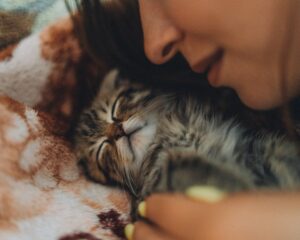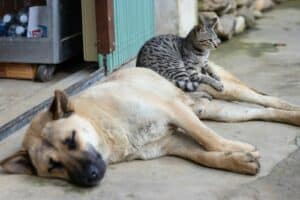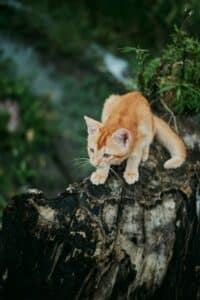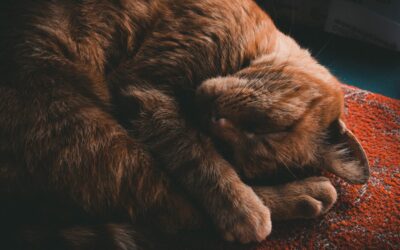If you’re a cat lover or a first-time pet owner, you might be enchanted by the idea of small cat breeds. Small cat breeds offer the perfect balance of cuteness and charisma, making them irresistible companions for any household.
In this blog post, we’ll explore the world of pint-sized cats, highlighting their unique characteristics and why they make wonderful everyday companions. From the playful Munchkin to the elegant Siamese, these miniature cats are sure to steal your heart.
Read on to discover the charm of small cat breeds and how they can bring joy and warmth to your home.

What Defines The Smallest Cat Breeds?
Small cat breeds are typically characterized by their diminutive size and weight. While the average cat weighs between 9 to 11 pounds, small cat breeds usually tip the scales at less than 8 pounds.
These tiny cats often have unique physical traits, such as short legs or large ears, and possess playful personalities that endear them to cat lovers everywhere.
Despite their small stature, these breeds are known for their robust health and energetic nature, proving that good things really do come in small packages.
The Health Benefits of Small Cat Breeds
Many small cat breeds are known for their robust health and long lifespans. Their petite size often means fewer joint problems and less strain on their bodies, contributing to a healthier life.
Additionally, their small frames make them more agile and active, which can lead to better overall fitness.
However, it’s essential to be aware of any breed-specific health issues and provide regular veterinary care to ensure your tiny companion stays in top shape.
Here are some famous small cat breeds to get you started!
The Adorable Munchkin Cat
Munchkin cats are easily recognizable in the cat world by their short legs and playful demeanor. This breed originated from a natural genetic mutation, resulting in their distinctive appearance.
Despite their short legs, Munchkin cats are incredibly agile and love to play, making them perfect companions for active households. Their kitten-like appearance and affectionate nature make them a favorite among cat enthusiasts.
The Elegant Siamese Cat
Siamese cats are one of the oldest known cat breeds, with a history that dates back centuries. Known for their long and slender torsos, large ears, and striking blue eyes, Siamese cats are both elegant and playful.
They are highly social and thrive on interaction, making them ideal for families and those who enjoy engaging with their pets. Siamese cats are also known for their vocal nature, often communicating with their owners through a variety of meows and chirps.
The Playful Devon Rex
The Devon Rex is a small cat breed known for its wavy coat texture and oversized ears. This breed is incredibly playful and loves to engage in activities like playing fetch.
Devon Rex cats are also known for their affectionate nature, often seeking out attention and cuddles from their owners. Their unique appearance and lively personalities make them a delightful addition to any home.
The Gentle Cornish Rex
Cornish Rex cats are another small breed who are also one od the oldest known cat breeds with a distinctive appearance. They have an egg-shaped head, close-lying silky fur, and a surprisingly muscular body.
Despite their delicate looks, Cornish Rex cats are quite robust and active. They are known for their affectionate and playful personalities, making them wonderful companions for families and individuals alike.
The Lovable American Curl
American Curl cats are easily recognizable by their distinctive curled ears. This breed is known for its affectionate and friendly nature, often forming strong bonds with their owners.
American Curls are active and playful, making them excellent companions for families with children. Their unique ears and loving personalities make them a standout among small cat breeds.
The Graceful Burmese Cat
Burmese cats are known for their sleek, muscular bodies and striking golden eyes. This breed originated in Burma and has since become a favorite among cat enthusiasts worldwide.
Burmese cats are affectionate and social, often seeking out attention and companionship from their owners. Their playful and curious nature makes them a joy to have around the house.
The Adventurous Japanese Bobtail
Japanese Bobtail cats are known for their pom-like tails and adventurous spirits. This breed is highly active and loves to explore its surroundings.
Japanese Bobtails are also known for their intelligence and playful personalities, making them excellent companions for those who enjoy engaging with their pets. At one time, they were the most commonly sighted street cat in Japan
Their distinctive appearance and lively nature make them a unique addition to any household.
The Active Somali Cat
Somali cats are known for their long, slender builds and bushy tails. This breed is highly active and loves to play, making them perfect for families with children or other pets.
Somali cats are also known for their affectionate nature and strong bonds with their owners. Their playful personalities and elegant appearance make them a favorite among cat lovers.

The Unique Genetic Mutations of Small Cat Breeds
Many small cat breeds owe their distinctive appearances to natural genetic mutations. These mutations can result in unique physical traits like short legs, curled ears, or wavy fur.
While these genetic variations make small cat breeds unique, it’s essential to be aware of any associated health issues. Regular veterinary care and proper breeding practices can help ensure these adorable cats live healthy and happy lives.
How to Care for Your Cat: Food and Water Essentials
Ensuring your cat receives proper nutrition and hydration is vital for their overall health and well-being. When it comes to food, provide a high-quality diet that is specifically formulated for cats.
Look for commercially prepared cat food that lists meat as the primary ingredient, as cats are obligate carnivores and require protein for energy and growth.
Consult with your veterinarian to determine the best food options based on your cat’s age, weight, and health conditions.
In addition to choosing the right food, be mindful of portion sizes to prevent obesity, a common issue in domestic cats. It’s also a good idea to establish a feeding schedule, whether that’s two meals a day or allowing free feeding, depending on your cat’s eating habits.
Water is equally important; cats need constant access to fresh water. Many cats prefer running water, so consider investing in a pet water fountain, which encourages them to drink more.
Regularly check and refill their water dish to ensure they remain hydrated, especially in warmer climates or if they consume dry food. Monitoring your cat’s food and water intake can help you detect any health issues early, making it an essential aspect of responsible cat care.

Understanding the Commitment of Getting a Cat
Bringing a cat into your home is more than just a decision to adopt a pet; it is a long-term commitment that requires careful consideration and planning. Cats can live anywhere from 12 to 20 years, and during this time, they rely on their owners for care, companionship, and a safe environment.
Understanding the responsibilities involved, including regular veterinary visits, proper nutrition, and daily playtime, is essential for their well-being.
Additionally, it’s important to consider factors such as lifestyle, space, and the financial implications of pet ownership. Potential cat owners should ensure they can provide the necessary time, effort, and resources to nurture their feline companion throughout their life, creating a fulfilling bond that enhances both their lives.

Tips for Introducing a New Cat to Existing Pets
Bringing a new cat into a home with existing pets requires careful planning and patience to foster peaceful interactions. Here are some practical tips to help ease the transition:
- Gradual Introduction: Start by allowing the new cat to explore a separate space in your home, away from other pets. This gives them time to acclimate to their new environment without feeling overwhelmed.
- Scent Exchange: Before any direct introduction, exchange bedding or toys between the new cat and existing pets. This helps them get used to each other’s scent, reducing territorial anxiety.
- Supervised Meetings: When the time comes for an introduction, do so in a controlled manner. Keep initial encounters short and supervised, watching for any signs of aggression or fear. Use treats to create positive associations.
- Provide Safe Spaces: Ensure that each pet has their own safe space to retreat to if they feel stressed. High perches, tunnels, or separate rooms can be effective for cats looking for solitude.
- Monitor Body Language: Pay close attention to your pets’ body language during introductions. Signs of happiness, like relaxed ears and a wagging tail, are positive, while hissing, growling, or puffing up indicates distress.
- Give It Time: Every animal is different, and some may take longer to adjust than others. Be patient and let the relationships develop naturally at their own pace.
- Maintain Routine: Stick to regular feeding schedules, playtime, and overall routines for all pets. Consistency can help ease anxiety and create a sense of normalcy in the midst of change.
- Seek Professional Help: If tensions remain high, consider consulting with a professional animal behaviorist for tailored advice and strategies to promote harmony among all your pets.
Taking these steps can create a smoother integration process and help your new cat feel at home while maintaining a peaceful environment for your existing pets.

Kate’s K9 Pet Care: Your Partner in Feline Care
At Kate’s K9 Pet Care, we understand that your feline companions deserve the best attention and care, even when you’re busy with work or other commitments.
Our dedicated team is here to cater to all your cat’s needs, ensuring they remain happy and engaged throughout the day.
Whether it’s playtime to stimulate their minds and bodies or delivering toys and cat food directly to your doorstep, we’ve got you covered.

Conclusion
Small cat breeds offer a delightful combination of charm, playfulness, and affection. From the mischievous Munchkin to the elegant Siamese, these tiny companions bring joy and warmth to any home.
Their unique physical traits and engaging personalities make them a favorite among cat lovers and first-time pet owners alike.
If you’re considering adding a small cat breed to your family, take the time to research and choose the one that best fits your lifestyle and preferences.
Ready to welcome a small cat breed into your home?
Explore our resources and connect with other cat enthusiasts to learn more about these charming companions. Whether you’re a first-time cat owner or a seasoned pet lover, there’s a perfect small cat breed waiting for you.







